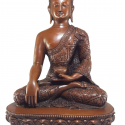Description
Tibetan Guru Rinpoche Statue from Nepal is made by the process of lost – wax system using copper material. The size of this statue is 36*26 cm(14*10 inch) and its weight is 4.2 kg (9.25 lbs).
| Weight | 4195 Grams – 9.25 lbs |
| Size | 36*26 cm (14*10 inch) |
| Material | Copper |
Iconography of Padmasambhava
The khatvanga is a staff with three heads that represent the three bodies of a Buddha: the dharmakaya, sambhogakaya, and nirmanakaya. It is topped with a trishula and adorned with a sash made of the Himalayan Rainbow or Five Pure Lights of the Mahabhuta. This sacred object is closely associated with Padmasambhava and is an important part of his visual depiction.
He has a sharp, intense look with both of his eyes wide open. He is dressed in multiple layers, starting with a white vajra undergarment, followed by a red robe, a dark blue mantrayana tunic, a red monastic shawl adorned with a golden flower design, and finally a maroon silk brocade cloak. He has one face and two hands.
He grasps a vajra with five prongs in his right hand, placing it close to his heart. In his left hand, which is positioned in a gesture of calmness, he holds a skull-shaped cup. Inside the cup, there is a vase filled with the immortal knowledge of wisdom.
He holds a three-pointed khatvanga, symbolizing his consort Mandarava, in his left arm. He wears a hat with five petals on his head. With a fierce yet joyful expression, he shines brightly with the majestic features and minor details. He sits in a regal position with both feet crossed.
Padmasambhava Mantra
The Padmasambhava mantra is Om Ah Hum Vajra Guru Padma Siddhi Hum.






































Reviews
There are no reviews yet.